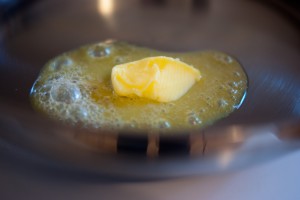Margarine is regularly advertised as being a healthy alternative to butter. With organizations such as the British Heart Foundation recommending consumption of margarine instead of butter to promote cardiovascular health, it is easy to believe that it is a healthy alternative. But how and why? Is this the case? This article will explore what each product is made of, the nutritional differences between them, and investigate the impact both will have on our health.
 Development and nutrition of margarine
Development and nutrition of margarine
Margarine has not always been made of plant based fats as it is today. Margarine was originally derived from animal fats (particularly beef), which are high in margeric acid, a fatty acid abundant in animals, from which the name margarine is derived from. Margarine originally served the purpose of a low cost alternative to butter for the military and poor people (not as a cheap way to fatten turkeys as some people may think). It was following the second world war, when supply of animal fats was extremely low, that vegetable oils were mixed in with the animal fat to produce enough margarine to meet demand. Eventually more and more vegetable oil was used in margarine, until animal fats were completely eliminated. Today, margarine is made up of a blend of a variety of plant derived fats, and some also blend these fats with regular butter. Common plants used to make margarine are olive, sunflower, soybean and rapeseed.
Margarine is very easy to modify due to various processing methods, and different plant derived fats. This allows margarine manufacturers make different varieties of margarine with different health claims such as ‘no trans-fats’, or ‘1/3 less saturated fat’. Typically, regular margarine, which is 80% fat, will contain the following quantities of fats:
- 15g Saturated fats
- 39g Mono-unsaturated fats
- 24g Poly-unsaturated fats (22g being omega-6, and small amounts being omega-3)
- up to 15g of trans-fats (made up of a mono and poly-unsaturated fats)
These quantities are very variable, and some companies which produce specialty margarines (such as reduced saturated fat/ no trans-fat), or use large amounts of specific oils (such as olive oil which is very high in omega-6) will have different ratios, but mono-unsaturated fats are typically the most abundant, followed by poly-unsaturated and then saturated fats. Omega-6 is the single most abundant fat, making up approximately 22g of the poly-unsaturateted fats.
Modern margarine and health
Poly-unsaturated fats (PUFAs) – These fats make up approximately a quarter of margarine, the most abundant being omega-6 fatty acids (see below). These fats are considered to be healthy within moderation, and protective against cardiovascular disease. Due to the large number of unsaturated bonds found in these fats, they are not very heat stable, and so cooking with these fats is not advisable. If these fats are heated up, they will react with the oxygen in the air, becoming oxidized, making them toxic and harmful to the body.
Linoleic acid (omega-6) – This is a poly-unsaturated fatty acid, and is the most abundant single fatty acid in margarine. Linoleic acid is abundant in vegetables, and is considered essential for the body as it cannot be synthesized from other fatty acids. Linoleic acid is important in the body, and moderate intake is associated with a reduced risk of cancer and protecting the cardiovascular system. Generally, omega-6 fatty acids are considered to be healthy, but an imbalance in the ratio of omega-6 to omega-3 (or too much omega-6) can result in the production of pro-inflammatory 2-series prostaglandins (PGE -2). This can increase inflammation (especially at sites of minor damage), which if persistent can increase the risk of a number of diseases, particularly cancer and cardiovascular disease. Too much omega-6/ an imbalance of omega-6 can also inhibit the production of EPA and DHA (important omega-3 fatty acids) from ALA (omega-3 fatty acids from nuts and seeds), as they pass through the same metabolic pathways.
Mono-unsaturated fats (MUFAs) – This group of fats make up the majority of modern margarine. Mono-unsaturated fats are abundant in many vegetable oils such as olive oil, which is over 70% mono-unsaturated fats. These fats are greatly associated with lowering LDL cholesterol and protecting the cardiovascular disease. There is some evidence to show that in large quantities mono-unsaturated fats can raise blood lipid levels, but in moderation, they are considered to be cardio-protective. Mono-unsaturated fats are more heat stable than polyunsaturated fats, and this is because they only have one saturated bond, which is the vulnerable point in the structure.
Saturated fats (SFAs) – Saturated fats make up the smallest portion of fats in margarine, and have been the source of much nutritional controversy. Saturated fats can be broken down into 3 groups which behave differently in the body: short chain, medium chain and long chain fatty acids. The saturated fats in margarine is predominantly long chain saturated fats (in particular palmitic acid and stearic acid), contains only small amounts of medium chain fats and no short chain fatty acids. Consumption of palmitic acid (which makes up nearly half of margarines saturated fats) has been shown to increase LDL level in the blood, and is considered to be an ‘unhealthy’ fat. Steric acid on the other hand, which makes up approximately one third of the total of saturated fats, is considered to be a healthy fat. Substituting palmitic acid with steric acid has been shown to reduce LDL cholesterol, and is considered beneficial for the cardiovascular system. These long chain fatty acids are poor source of energy, and so rarely used as a source of energy in the body during respiration.
Trans-fats – The term trans-fat refers to the shape of a fat, and both mono-unsaturated and poly-unsaturated fats can be trans-fats. Trans-fats can be commonly occurring in nature, or can be man-made. Man-made trans-fats are used to manipulate the texture of products such as ice cream or margarine, and indeed, all the trans-fats in margarine are man-made. Man-made trans-fats are considered to be ‘bad’ fats, and there is overwhelming evidence to show that they negatively impact the cardiovascular system, and increase levels of LDL cholesterol.
Micronutrients – The micro-nutrient content of margarine is very variable due to the different vegetable oils in which it can be made from. However, typically, margarine will contain significant amounts of vitamin A, E and K. There is very little mineral content of margarine.
 Development and nutrition of butter
Development and nutrition of butter
Butter’s ingredients have not changed much since its early development, and is still made of milk fat which is churned, however, the processing for butter has changed quite dramatically. Originally, the milk used to produce butter would not have been pasteurized, and would have started to ferment before processing, which would have preserved and produced a number of beneficial nutrients in the butter. Modern butter will not be fermented, and will be pasteurized, which will destroy/ prevent these nutrients forming. It is still possible to purchase ‘cultured/ fermented butter’, but what most people know as butter today is pastured and not fermented.
Typically, modern butter will have the following amounts of fats in per 100g.
- 51g Saturated fat
- 21g Mono-unsaturated fats
- 3g Poly-unsaturated fats
Modern butter and health
Saturated fats – These fats are the most abundant fats in butter, but unlike margarine, these saturated fats are made up of a combination of short chain, medium chain and long chain fatty acids. Short chain saturated fatty acids have been shown to be beneficial for the digestive system health. These fatty acids promote the population of the probiotic Bifidobacteria spp, maintain optimal pH and the aid normal passage of a stool. Short chain fatty acids are considered to be ‘good’ fats. Medium chain fatty acids are also considered to be healthy fats, and have demonstrated significent cardio-protective properties and are easily converted into usable energy by the body, and do not produce the insulin spike that sugars are associated with – making them a favorable source of sustainable energy for many. It is medium chain fatty acids which give coconut oil its health benefits (in particular lauric acid, of which butter is approximately 2.5%). Of the long chain fatty acids, butter is high in both palmitic and steric acid (as is margarine).
Mono-unsaturated fats – Mono-unsaturated fats make up 21% of the fats in butter, which is a nutritionally significant amount. Butter will contain a variety of these fats (as does margarine), so for information on these mono-unsaturated fats, read the section above.
Poly-unsaturated fats – The quantity of poly-unsaturated fats in butter is almost negligible, but of this 3g approximately 2g are omega-6.
Micro-nutrients – Modern butter will contain significant amounts of vitamin A, E and K, but often to a lesser extent than margarine. There is also very little mineral content in butter, with the most abundant mineral being calcium which is found in small quantities. Traditional fermented butter contains much more nutrients than modern butter.
Summary
Margarine is abundant in a number of fats which clinical studies have shown to be beneficial for the cardiovascular system, however, the saturated fats are all long chain, some of which have a negative effect on the cardiovascular system. The amount of these long chain fatty acids is relatively low compared to the other fatty acids which make up margarine, so theirnergative impact may be minimal. One area of concern is the extremely high amount of omega-6 in margarine, which will put consumers at risk of consuming too much omega-6. This can cause an unbalance in omega-3 to omega-6 fatty acids, which can disrupt omega-3 metabolism and promote inflammation. Some margarine (not all) can also contain up to 15% man made trans-fats, these trans-fats are known to have seriously negative effects on the cardiovascular system, and can increase LDL levels. It is also not recommended to cook with margarine as the abundance of mono and poly-unsaturated fats which can easily be damaged by heat and become toxic.
Butter contains much more saturated fats than margarine, but these fats include short chain, medium chain and long chain fatty acids. These short and medium chain fats are great sources of energy, promote digestive system health as well as cardiovascular health. As with margarine though, there are also some long chain fatty acids which are associated with having negative effects on the cardiovascular system. Butter also does contain significant amount of mono-unstated fats too, which are known for their cardio-protective properties. It healthier to cook with butter than margarine because butter does contain much more saturated fats, however, the mono-unsaturated fats in butter are still vulnerable to oxidation in butter.
Images courtesy of Warmest Regards, sarflondondunc and tarale.

